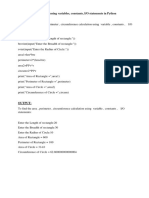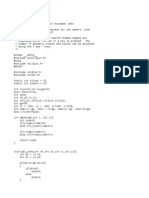Op First
Op First
Uploaded by
Tayub khan.ACopyright:
Available Formats
Op First
Op First
Uploaded by
Tayub khan.AOriginal Title
Copyright
Available Formats
Share this document
Did you find this document useful?
Is this content inappropriate?
Copyright:
Available Formats
Op First
Op First
Uploaded by
Tayub khan.ACopyright:
Available Formats
1.
Write a function that inputs a number and prints the multiplication table
In [8]: def mul_table(n):
'''This function prints the multiplication table a the given number'''
for i in range (1,11):
m=i*n
print("{}x{}={}".format(n,i,m))
n = int(input("Enter a number : "))
print("The multiplication table of {} is : ".format(n))
mul_table(n)
Enter a number : 5
The multiplication table of 5 is :
5x1=5
5x2=10
5x3=15
5x4=20
5x5=25
5x6=30
5x7=35
5x8=40
5x9=45
5x10=50
1. Write a program to print twin primes less than 1000. If two consecutive odd numbers are both prime then they are known as twin
primes.
In [9]: def comp_prm(b):
'''This function gets the prime numbers less than 1000'''
for e in range(2,(b//2)+1):
if b%e==0:
return False
return True
def twin_no(a,b):
'''This function prints the twin primes less than 1000'''
for c in range(a,b):
d=c+2
if (comp_prm(c)&comp_prm(d)):
print("[{},{}]".format(c,d))
print("twin prime less then 1000 are : ")
twin_no(2,1000)
twin prime less then 1000 are :
[3,5]
[5,7]
[11,13]
[17,19]
[29,31]
[41,43]
[59,61]
[71,73]
[101,103]
[107,109]
[137,139]
[149,151]
[179,181]
[191,193]
[197,199]
[227,229]
[239,241]
[269,271]
[281,283]
[311,313]
[347,349]
[419,421]
[431,433]
[461,463]
[521,523]
[569,571]
[599,601]
[617,619]
[641,643]
[659,661]
[809,811]
[821,823]
[827,829]
[857,859]
[881,883]
1. Write a program to find out the prime factors of a number example : prime factors of 56-2,2,2,7
In [10]: n=56
print("Prime factors of {} is : ".format(n),end=" ")
if n<2:
print(int(n))
while(n%2==0):
print(2,end=" ")
n=n/2
for i in range(3,int(n)+1,2):
while(n%i==0):
print(i,end=" ")
n=n/i
Prime factors of 56 is : 2 2 2 7
1. Write a program to implement these formulae of permutations and combinations. Number of permutations of n objects taken r at a
time is : p(n,r)=n!/(n-r)!. Number of combinations of n objects taken r at a time is : c(n,r)=n!/(r!(n-r)!)=p(n,r)/r!
In [11]: def factorial(n):
'''This function gets the factorial of a number'''
return 1 if n==1 else(n*factorial(n-1))
n=15
r=4
print("Number of permutations of n objects taken r at a time : p(n,r) = {}".format(int(factorial(n)/factorial(n
print("Number of combinations of n objects taken r at a time : c(n,r) = {}".format(int(factorial(n)/(factorial(
Number of permutations of n objects taken r at a time : p(n,r) = 32760
Number of combinations of n objects taken r at a time : c(n,r) = 1365
1. Write a function that converts a decimal number to binary number.
In [12]: def deci_to_bin(n):
'''This function converts decimal number to binary'''
if n>0:
x=[]
while n:
r=n%2
x.append(r)
n=n//2
y=x[::-1]
y.insert(0,0)
return(y)
elif(n==0):
return 0
elif(n<0):
m=-n
x=[]
while m:
r=m%2
x.append(r)
m=m//2
y=x[::-1]
y.insert(0,1)
return(y)
n=-10
print(deci_to_bin(n))
[1, 1, 0, 1, 0]
1. Write a function cubesum() that accepts an integer and return the sum of the cubes of individual digits of that number. Use this
function to move function print Armstrong() and isArmstrong() to print Armstrong numbers and to find whether is an Armstrong
number.
In [13]: def cubesum(n):
'''This function returns the sum of cubes of individual digits of the number'''
x=n
sum=0
while x>0:
i=x%10
sum=sum+i**3
x=x//10
return(sum)
n=407
cubesum(n)
407
Out[13]:
In [14]: def PrintArmstrong(n):
'''This function prints Armstrong number within a range'''
for n in range(n):
if n==cubesum(n):
print("{} is an armstrong number".format(n))
n=1000
PrintArmstrong(n)
0 is an armstrong number
1 is an armstrong number
153 is an armstrong number
370 is an armstrong number
371 is an armstrong number
407 is an armstrong number
In [15]: def isArmstrong(n):
'''This function determines whether a number is an Armstrong number or not'''
if n==cubesum(n):
return("Yes, it is an armstrong number")
else:
return("No, it is not an armstrong number")
n=371
isArmstrong(n)
'Yes, it is an armstrong number'
Out[15]:
1. Write a function prodDigits() that inputs a number and returns the product of digits of that number.
In [23]: def ProdDigits(x):
'''Fuction to print the product of the digits'''
y=x
prd=1
while(y>0):
z=y%10
prd=prd*z
y=int(y/10)
return(prd)
x=int(input("Enter the digits : "))
ProdDigits(x)
Enter the digits : 23
6
Out[23]:
1. If all digits of a number n are multiplied by each other repeating with the product, the one digits number obtained at last is called
the Multiplicative digits root of n. The number of times digits need to be multiplied to reach one digit is called the multiplicative
persistance of n. Example: 86 -> 48 -> 32 -> 6 (MDR 6, MPersistance 3)
341 -> 12 -> 2 (MDR 2, MPersistance 2)
Using the function prodDigits() of previous excercise write functions MDR() and MPersistance() that inputs a number and return its
Multiplicative digital root and Multiplicative persistence respectively.
In [24]: def MDR():
'''This function prints the Multiplicative digital root of a number'''
a1=ProdDigits(x)
while(a1>10):
a2=ProdDigits(a1)
a1=a2
return(a2)
x=int(input("Enter the number : "))
print("The Multiplicative digital root of {} is {}".format(x,MDR()))
Enter the number : 34
The Multiplicative digital root of 34 is 2
In [25]: def MPersistence():
'''This function print the Multiplicative persistence of a number '''
a1=ProdDigits(x)
count=1
while(a1>10):
a2=ProdDigits(a1)
a1=a2
count+=1
return(count)
x=int(input("Enter the number : "))
print("The Multiplicative Persistence of {} is {}".format(x,MPersistence()))
Enter the number : 34
The Multiplicative Persistence of 34 is 2
1. Write a function sumPdivisors() that finds the sum of proper divisors of a number. Properdivisors of a number are those numbers by
which the number is divisible, except the numbers itself. For example proper divisors of 36 are 1,2,3,4,6,9,18.
In [26]: def sumPdivisors(n):
'''This fuction finds the sum of proper divisors of a number'''
sum=0
for i in range(1,n):
if (n%i==0):
sum=sum+i
return(sum)
n=9
sumPdivisors(n)
4
Out[26]:
1. A number is called perfect if the sum of proper divisors of the number is equal to the number. For example 28 is perfect number,
since 1+2+4+7+14=28. Write a program to print all the perfect numbers in a given range.
In [27]: for j in range (5,10000):
sum=0
for i in range(1,j):
if (j%i==0):
sum=sum+i
if (sum==j):
print("{} is a perfect number".format(sum))
6 is a perfect number
28 is a perfect number
496 is a perfect number
8128 is a perfect number
1. Two different numbers are called amicable numbers if the sum of the proper divisors of each is equal to the other number. For
example 220 and 284 are amicable numbers. sum of proper divisor of 220 = 1+2+4+5+10+11+20+22+44+55+110=284 sum of
proper divisor of 284 = 1+2+4+71+142=220. write a function to print pairs of amicable numbers in a range.
In [29]: def amicable(n):
'''This functions prints pairs of amicable numbers in a range'''
for i in range(n):
for j in range(n):
if (i!=j):
if (i<j):
if (sumPdivisors(i)==j and sumPdivisors(j)==i):
print("{} and {} are amicable numbers within range {}".format(i,j,n))
n=1220
amicable(n)
220 and 284 are amicable numbers within range 1220
1184 and 1210 are amicable numbers within range 1220
1. Write a program which can filter odd numbers in a list by using filter function.
In [30]: n=[8,5,66,99,45,13,11,9,7,12,98,77,57]
odd_list=list(filter(lambda x:(x%2==1),n))
print(odd_list)
[5, 99, 45, 13, 11, 9, 7, 77, 57]
1. Write a program which can map() to make a list whose elements are cube of elements in a given list
In [31]: n=[8,5,66,99,45,13,11,9,7,12,98,77,57]
cube_of_eles=list(map(lambda x:x**3,n))
print(cube_of_eles)
[512, 125, 287496, 970299, 91125, 2197, 1331, 729, 343, 1728, 941192, 456533, 185193]
1. Write a program which can map() and filter() to make a list whose elements are cube of even number in a given list.
In [32]: n=[8,5,66,99,45,13,11,9,7,12,98,77,57]
even_list=list(filter(lambda x:(x%2==0),n))
cube_of_even=list(map(lambda x:(x**3),even_list))
print(cube_of_even)
[512, 287496, 1728, 941192]
You might also like
- Solutions On Python FunctionsDocument1 pageSolutions On Python FunctionsJason ShaxNo ratings yet
- Optional Assignment 1Document11 pagesOptional Assignment 1Rahul YadavNo ratings yet
- Computing Fundamentals Using PythonDocument11 pagesComputing Fundamentals Using Pythontarunsudhakar2006No ratings yet
- Function Assignment PDFDocument6 pagesFunction Assignment PDFChiranjeet Sarkar100% (1)
- 44DBD3C517136789270Document21 pages44DBD3C517136789270Keerthi bolimeraNo ratings yet
- PracticalDocument15 pagesPracticalSunil Kumar AthmakuruNo ratings yet
- Assignment 1 PythonDocument1 pageAssignment 1 PythonAashish AryaNo ratings yet
- ProgramsDocument8 pagesProgramsSneha ThyagarajanNo ratings yet
- CS018 - Python Lab ManualDocument28 pagesCS018 - Python Lab ManualChamarthi HarshithaNo ratings yet
- ai fileDocument30 pagesai fileAayan AhmedNo ratings yet
- Python Lab WorkDocument4 pagesPython Lab Workhjai8015No ratings yet
- PyCon India 2012 NotebookDocument10 pagesPyCon India 2012 NotebookSin JuneNo ratings yet
- PhythonDocument19 pagesPhythonKarthikNo ratings yet
- PYTHON LAB MANUAL Name: Jitendra Kumar Roll No.: 05035304421 Section: 2Document20 pagesPYTHON LAB MANUAL Name: Jitendra Kumar Roll No.: 05035304421 Section: 2Daily VloggerNo ratings yet
- Exp - 2 - SC - 2024 (Sharon Suresh) - Jupyter NotebookDocument4 pagesExp - 2 - SC - 2024 (Sharon Suresh) - Jupyter Notebookbrutalforce398No ratings yet
- Programs On OperatorsDocument15 pagesPrograms On OperatorsJayamangalaSristiNo ratings yet
- E.G. - If Input Is (12, 54, 49, 86, 23, 36) Then Modified List Is (32, 18, 16, 106, 43, 12)Document6 pagesE.G. - If Input Is (12, 54, 49, 86, 23, 36) Then Modified List Is (32, 18, 16, 106, 43, 12)Tanisha JenaNo ratings yet
- Document ImpDocument16 pagesDocument ImpffffffgNo ratings yet
- Practical FileDocument50 pagesPractical FileVishalNo ratings yet
- R Programs I Mba II SemDocument11 pagesR Programs I Mba II SemYeswanth KumarNo ratings yet
- # Python3 Program To Swap First and Last Element of A ListDocument25 pages# Python3 Program To Swap First and Last Element of A ListJomaina AhmedNo ratings yet
- FunctionsDocument7 pagesFunctionssing blingNo ratings yet
- Index: S.no. Name of The Experiment DateDocument14 pagesIndex: S.no. Name of The Experiment DateAman SinghNo ratings yet
- Python ProgramsDocument35 pagesPython ProgramsnikhilNo ratings yet
- Python 10M Q&ADocument48 pagesPython 10M Q&AVinod KumarNo ratings yet
- Functions - 2 MarksDocument14 pagesFunctions - 2 Marksj4siiiimNo ratings yet
- FunctionsDocument16 pagesFunctionsSaiPriya Eluri AP20110010491No ratings yet
- Lab-Phython ProgramDocument15 pagesLab-Phython Programsachidanandyaba445No ratings yet
- Python ExampleDocument43 pagesPython ExampleSri AshishNo ratings yet
- A "Welcome in C Programming Class Welcome Again To C Class !" B A.lower C B.split D Set (C) Print (Len (D) )Document5 pagesA "Welcome in C Programming Class Welcome Again To C Class !" B A.lower C B.split D Set (C) Print (Len (D) )Ranjeet SinghNo ratings yet
- Programming in Python Assignment - DHANANJAY SINGHALDocument30 pagesProgramming in Python Assignment - DHANANJAY SINGHALShubh SharmaNo ratings yet
- PracticalDocument64 pagesPracticalAdityaNo ratings yet
- Programs 1Document15 pagesPrograms 1MurugeshNo ratings yet
- CP104 - Chapter 5 FunctionsDocument7 pagesCP104 - Chapter 5 Functionsjuliamicic10No ratings yet
- Practical Assignment Xi SC (CS) - 2022-23Document8 pagesPractical Assignment Xi SC (CS) - 2022-23Adarsh Kumar PadhanNo ratings yet
- Practical Assignment-While+For LoopDocument9 pagesPractical Assignment-While+For LoopApoorva TomarNo ratings yet
- Even ODD SolDocument6 pagesEven ODD SolKyle hallNo ratings yet
- Lokesh HeroDocument42 pagesLokesh HeroKamlesh kNo ratings yet
- LokeshDocument31 pagesLokeshKamlesh kNo ratings yet
- Working With Function 1Document9 pagesWorking With Function 1sarvesh2016.spNo ratings yet
- Python Lab ManualDocument6 pagesPython Lab ManualBindu KNNo ratings yet
- Python Lab ProgramsDocument14 pagesPython Lab ProgramsMJAYASURYANo ratings yet
- Class11 Programs ManualDocument21 pagesClass11 Programs Manualwosolir748No ratings yet
- XI CS Practical File 2022-23Document17 pagesXI CS Practical File 2022-23Tushar SharmaNo ratings yet
- Assignment Python 5Document2 pagesAssignment Python 5rushukumar11No ratings yet
- Basic Python Programs by PST IT SOLUTIONSDocument12 pagesBasic Python Programs by PST IT SOLUTIONSpawar.sandesh5No ratings yet
- Exercise 1Document17 pagesExercise 1Trevor EricksonNo ratings yet
- 21bei042 Prac05Document5 pages21bei042 Prac05MeenaNo ratings yet
- Python AssignmentDocument13 pagesPython Assignmenthuma shadmeenNo ratings yet
- Prob13: 1 EE16A Homework 13Document23 pagesProb13: 1 EE16A Homework 13Michael ARKNo ratings yet
- Python SolutionsDocument21 pagesPython SolutionsDisha GoelNo ratings yet
- Practical Programs - 24-25-1Document20 pagesPractical Programs - 24-25-1ashika2731No ratings yet
- Python Lab Programs 1. To Write A Python Program To Find GCD of Two NumbersDocument12 pagesPython Lab Programs 1. To Write A Python Program To Find GCD of Two NumbersAYUSHI DEOTARENo ratings yet
- 11 ProgramsDocument9 pages11 ProgramsSushila KrishniaNo ratings yet
- Pyhton Practicals PDFDocument17 pagesPyhton Practicals PDFMegha SundriyalNo ratings yet
- If 4 If If Else Else Else: Int InputDocument15 pagesIf 4 If If Else Else Else: Int InputRajesh KoneNo ratings yet
- Design and Analysis of Algorithms Lab Aman DubeyDocument11 pagesDesign and Analysis of Algorithms Lab Aman DubeyRythmNo ratings yet
- Week 11 AppDocument6 pagesWeek 11 Appishankalathil79No ratings yet
- Python Program ListDocument7 pagesPython Program Listbharathkannan24035No ratings yet
- IDL ENVI Reference Guide PDFDocument774 pagesIDL ENVI Reference Guide PDFAshoka VanjareNo ratings yet
- AppdevDocument45 pagesAppdevbookwormMDNo ratings yet
- 08CS1012Document2 pages08CS1012Siddhartha JainNo ratings yet
- 7 Keys To STO Success Introduction PDFDocument28 pages7 Keys To STO Success Introduction PDFEzomar UzcáteguiNo ratings yet
- ALB Names DivisionsDocument7 pagesALB Names Divisionsichigo_bleach00No ratings yet
- ProposalDocument9 pagesProposalAshish DuttNo ratings yet
- RA CPA DAVAO May2018 PDFDocument30 pagesRA CPA DAVAO May2018 PDFPhilBoardResultsNo ratings yet
- 16.unit Wise Quiz QuestionsDocument56 pages16.unit Wise Quiz QuestionsVeeraNo ratings yet
- SYMCLI Cheet Sheet: Leave A CommentDocument5 pagesSYMCLI Cheet Sheet: Leave A CommentPavan KamishettiNo ratings yet
- BoneXpert BrochureDocument1 pageBoneXpert BrochurestickorzNo ratings yet
- Design of Bus Tracking and Fuel Monitoring SystemDocument5 pagesDesign of Bus Tracking and Fuel Monitoring SystemShamran HNo ratings yet
- Wxglade User ManualDocument23 pagesWxglade User ManualJose Miguel Aniorte HernándezNo ratings yet
- Arch IT - Internal Audit Job DescriptionDocument2 pagesArch IT - Internal Audit Job DescriptionS GDNo ratings yet
- Cob ProcessingDocument29 pagesCob ProcessingAreef75% (4)
- Mono APA English 4Document66 pagesMono APA English 4Jose Tochi EspinozaNo ratings yet
- TOS (1Q-Grade 7)Document2 pagesTOS (1Q-Grade 7)Angelica LazoNo ratings yet
- VillarrealrpDocument4 pagesVillarrealrpapi-439331358No ratings yet
- Caeds 3340905 PDFDocument6 pagesCaeds 3340905 PDFAnonymous XeWx1sR4No ratings yet
- Case Study Based On Intrusion Detection SystemDocument5 pagesCase Study Based On Intrusion Detection SystemAnonymous tIi0h0100% (1)
- Comparison of Spectral Decomposition Algorithms For Channel Detection in 3D Seismic DataDocument4 pagesComparison of Spectral Decomposition Algorithms For Channel Detection in 3D Seismic DataKurniasari FitriaNo ratings yet
- CSCI 104 Classes: Mark Redekopp David KempeDocument32 pagesCSCI 104 Classes: Mark Redekopp David KempeAsutosh MohapatraNo ratings yet
- 5 Ways To Create PDF Files - Wikihow PDFDocument18 pages5 Ways To Create PDF Files - Wikihow PDFCos SkilNo ratings yet
- CCN Lab Manual For 6sem PDFDocument32 pagesCCN Lab Manual For 6sem PDFKiran kd0% (1)
- DX DiagDocument11 pagesDX DiagAnonymous EqtTJXFNo ratings yet
- RF and Microwave Group Electronics Department IIT (ISM) DhanbadDocument8 pagesRF and Microwave Group Electronics Department IIT (ISM) Dhanbadpravin maliNo ratings yet
- Variational CalculusDocument3 pagesVariational Calculusabsiddou100% (1)
- Data MiningDocument9 pagesData MiningChethan.M100% (4)
- GLUT Shapes Dem-WPS OfficeDocument7 pagesGLUT Shapes Dem-WPS OfficeAgs SlmNo ratings yet
- Cs 4142Document6 pagesCs 4142Devika DakhoreNo ratings yet
- CSS Tips & TricksDocument4 pagesCSS Tips & TricksShital JoshiNo ratings yet

























































































